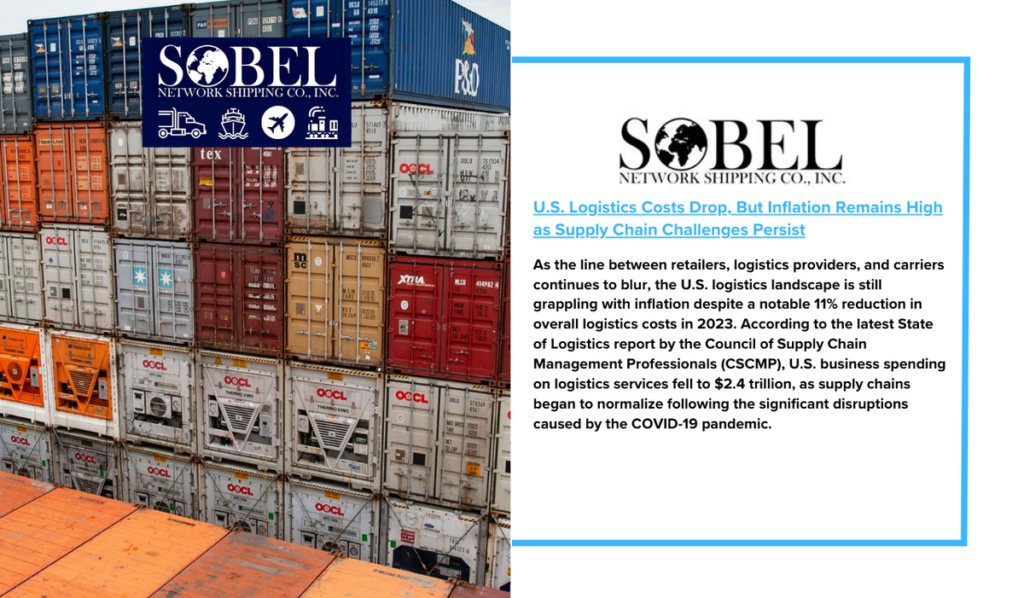As the line between retailers, logistics providers, and carriers continues to blur, the U.S. logistics landscape is still grappling with inflation despite a notable 11% reduction in overall logistics costs in 2023. According to the latest State of Logistics report by the Council of Supply Chain Management Professionals (CSCMP), U.S. business spending on logistics services fell to $2.4 trillion, as supply chains began to normalize following the significant disruptions caused by the COVID-19 pandemic.
While logistics costs have declined, they remain elevated after surging 22.4% in 2021 and nearly 20% in 2022. Prior to the pandemic, the baseline spending on logistics was $1.5 trillion. Moreover, the report highlighted that the ratio of logistics costs to U.S. GDP, an indicator of efficiency, dropped to 8.7% in 2023 from 9.1% in 2022. However, it remains above the pre-pandemic ratio of 7.7% in 2019.
Supply Chain Volatility and the Need for Resilience
The report underscores that volatility is now the norm in global supply chains. Factors such as geopolitical tensions, climate change, and fluctuating consumer demand continue to create uncertainty. Many logistics providers and shippers have yet to fully invest in technologies and infrastructure that would allow them to mitigate these disruptions effectively.
For example, some companies have started rerouting shipments around Africa to avoid instability in the Red Sea or adapting to low water levels in the Panama Canal. These longer transit routes increase costs and require more flexible transportation strategies.
Freight Market Trends: A Mixed Bag
Last year saw soft demand for freight services, especially in trucking. Although there was a late-year surge in ocean and air freight volumes driven by e-commerce, the overall demand for transportation services remained low, leading to reduced cargo rates. According to Kearney’s analysis in the report, while there is currently an overcapacity in transportation and storage, capacity tightening and rising rates may be on the horizon, particularly in the air and ocean freight sectors.
In the trucking industry, overcapacity continued to drive down rates, leading to the closure of more than 1,000 truck brokers. However, many survived due to the extraordinary profits generated in the years prior. As consumer sentiment, inventory rebuilding, and broader economic factors remain uncertain, trucking prices are expected to gradually recover by late 2024 or early 2025.
Shifts in the Parcel and Rail Markets
The parcel delivery sector has also been impacted by changing dynamics. Major players like UPS saw a 7.4% drop in domestic volume, while Amazon surpassed both FedEx and UPS in total U.S. deliveries. Large shippers have increasingly diversified their carrier networks, turning to regional and local options to secure better rates in a complex pricing environment.
The rail industry experienced a modest increase in traffic, but revenues for Class 1 railroads fell by 2%, contributing to an 11% decline in operating income. Intermodal volumes dropped 6% year over year, although the report is optimistic about future growth due to the increased relocation of manufacturing operations to Mexico.
High Inventory Levels and Emerging Trends
Inventory levels, which surged during the pandemic, have finally started to stabilize. Many companies had stockpiled goods to mitigate manufacturing and transportation delays, but most of the excess inventory has now been cleared. However, the future demand for logistics services remains uncertain. Weak global economic growth is forecasted through 2030, and unforeseen disruptions—whether geopolitical, weather-related, or labor-driven—could drastically alter supply chain dynamics.
An emerging trend noted in the report is the increasing commercialization of in-house logistics operations by major companies like Amazon and Pepsi Logistics Co. These corporations, with excess trucking capacity, are transforming their logistics divisions into profit centers by offering services such as drop trailers and fleet management to third parties.
Investment Challenges Amid High Interest Rates
The high cost of borrowing, due to 7% interest rates, is making it difficult for companies to invest in logistics technology and infrastructure. Many organizations are now weighing whether to invest in hard assets like transportation equipment and warehouses, or focus on automation, visibility, and inventory control technologies. As the cost of capital rises, this decision becomes even more critical.
In summary, while logistics costs have decreased, the industry faces ongoing challenges due to inflation, capacity constraints, and rising interest rates. Companies must adapt to the new normal of supply chain volatility and make strategic investments to remain competitive in a shifting market.


